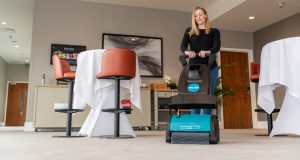An unclean office doesn’t just make for an unpleasant working environment but can have serious ramifications on the health of all those spending time there. As the country prepares for a staggered return to work following the COVID-19 pandemic, issues of cleanliness and hygiene around the office are more important than ever.
Offices are breeding grounds for bacteria. Without an extensive sanitisation and cleaning routine, illness can quickly spread. But which areas of the office are the worst offenders when it comes to bacteria? Office suppliers Viking investigated just that, carrying out an experiment to see how dirty the average office really is. The resulting samples, taken from common objects around the office, show just how important it is to keep a workspace clean.
So, just how much bacteria is there in the average office?
Desks
You’ll likely spend most of the working day at your desk, feeling comfortable placing cups of tea there or even eating your lunch from it. However, as the sample shows, the average office desk is a hotspot for all different types of bacteria due to the wide range of things it comes into contact with on a daily basis.
Most office cleaning routines will already include desks. However, it is important to also clean any equipment, monitors, or stationary to eliminate hidden germs.

Office doors
Office doors are handled by every single person who enters the space, so naturally, any bacteria around the office will be transferred to them. This sample shows bacteria on an office door that is cleaned daily, meaning this bacteria is from just a single day’s worth of contact and exposure. This shows the importance of amplifying any existing office cleaning routines during COVID-19, as bacteria can quickly grow between daily cleans.

Hot water boiler
When considering bacterial hotspots in the office, the hot water boiler is unlikely to be the first thing that springs to mind. But as the sample shows, the boiler can contain a surprising range of bacteria. Due to the heat of a hot water boiler, bacteria can grow quickly on its surface. Combine this with the fact that it may not be top of the cleaning list, and your hot water boiler could quickly cause you problems.

Photocopier
Another unexpected culprit for bacteria around the office is the photocopier. This piece of office equipment is used by a wide range of people but, like the hot water boiler, is not always prioritised for cleaning. This makes it a prime point of contagion for spreading illnesses. As well as desks and personal equipment, wider office equipment such as copiers should be sanitised regularly to keep bacteria at bay.

Pens and pencils
Most of us wouldn’t think twice about borrowing a pen from a colleague but doing so could put your health at risk. Chewed pens and pencils harbour an extensive range of bacteria, even after they’ve been sat ‘unchewed’ for multiple days. The shocking bacteria found in this sample just goes to show how careful we need to be with everyday items such as pens and pencils, as they can quickly become a point of contagion. You should wipe down any frequently used items regularly, and remember to never place objects in your mouth or close to your face – especially if they belong to somebody else.


Mouse
The final swab was taken from a computer mouse and, unsurprisingly, shows a large bacterial growth. Compare this to the ‘clean’ sample, which shows a mouse after being wiped down with generic desk wipes, and you can truly understand the importance of cleaning your office equipment and work surfaces.


Regular cleaning around the office should be a given, but especially as we return to work following COVID-19. This selection of bacteria shows just how easily germs and illnesses can spread – sometimes in unexpected areas.
It takes a group effort to keep an office clean. Make sure everyone is regularly washing or sanitising their hands, equipment is wiped down, and communal areas are cleaned frequently, and you’ll be well on your way to promoting a safer and more hygienic office environment.





